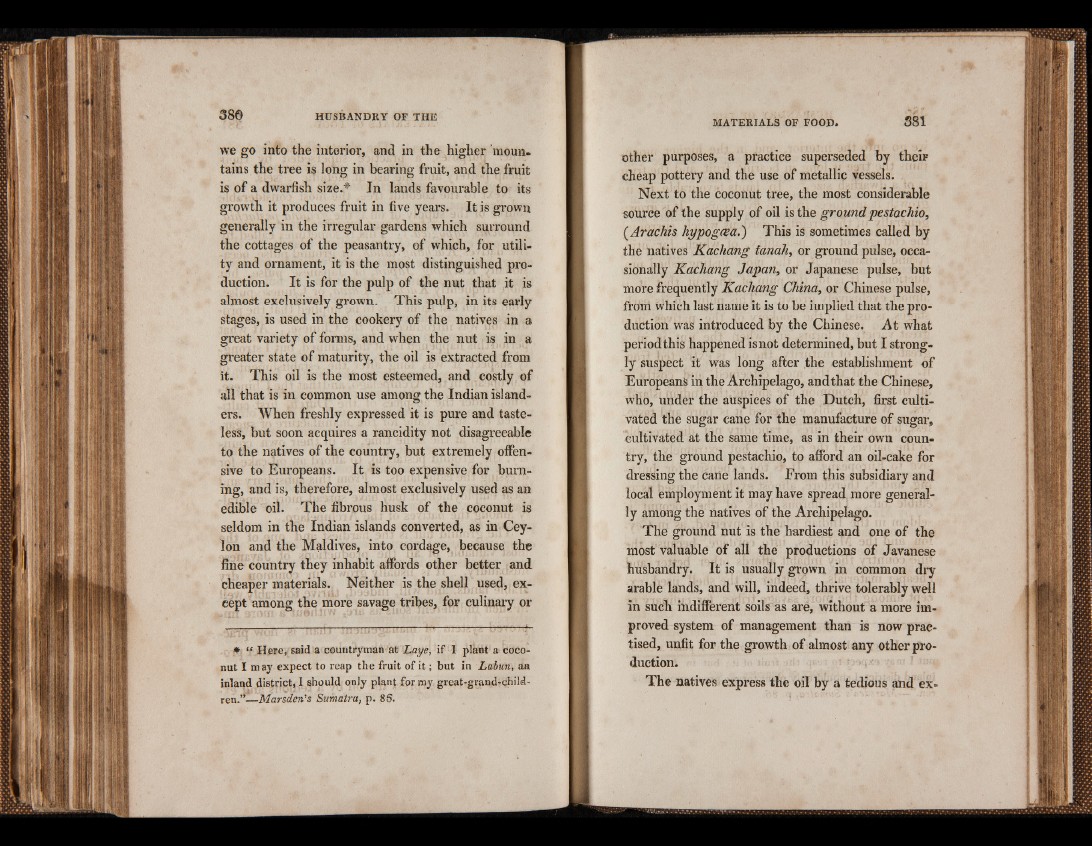
we go into the interior, and in the higher mountains
the tree is long in bearing fruit, and the fruit
is of a dwarfish size.* In lands favourable to its
growth it produces fruit in five years. It is grown
generally in the irregular gardens which surround
the cottages of the peasantry, of which, for utility
and ornament, it is the most distinguished production.
It is for the pulp of the nut that it is
almost exclusively grown. This pulp, in its early
stages, is used in the cookery of the natives in a
great variety of forms, and when the nut is in a
greater state of maturity, the oil is extracted from
it. This oil is the most esteemed, and costly of
all that is in common use among the Indian islanders.
When freshly expressed it is pure and tasteless,
but soon acquires a rancidity not disagreeable
to the natives of the country, but extremely offensive
to Europeans. It is too expensive for burning,
and is, therefore, almost exclusively used as an
edible oil. The fibrous husk of the coconut is
seldom in the Indian islands converted, as in Ceylon
and the Maldives, into cordage, because the
fine country they inhabit affords other better and
cheaper materials. Neither is the shell used, except
among the more savage tribes, for culinary or
* Here, said a countryman at Laye, if I plant a coconut
I may expect to reap the fruit of i t ; but in Labun, aa
inland district, I should only plant for my great-grand-child-
ren.”—Marsden's Sumatra, p. 86.
other purposes, a practice superseded by their
cheap pottery and the use of metallic vessels.
Next to the coconut tree, the most considerable
source of the supply of oil is the groundpestachio,
(Arachis hypogoea.') This is sometimes called by
the natives Kachang tanahy or ground pulse, occasionally
Kachang Japan, or Japanese pulse, but
more frequently Kachang China, or Chinese pulse,
from which last name it is to be implied that the production
was introduced by the Chinese. At what
period this happened isnot determined, but I strongly
suspect it was long after the establishment of
Europeans in the Archipelago, andthat the Chinese,
who, under the auspices of the Dutch, first cultivated
the sugar cane for the manufacture of sugar,
cultivated at the same time, as in their own country,
the ground pestachio, to afford an oil-cake for
dressing the cane lands. From this subsidiary and
local employment it may have spread more generally
among the natives of the Archipelago.
The ground nut is the hardiest and one of the
most valuable of all the productions of Javanese
husbandry. It is usually grown in common dry
arable lands, and will, indeed, thrive tolerably well
in such indifferent soils as aré, without a more improved
system of management than is now practised,
unfit for the growth of almost any other production.
The natives express the oil by a tedious and ex